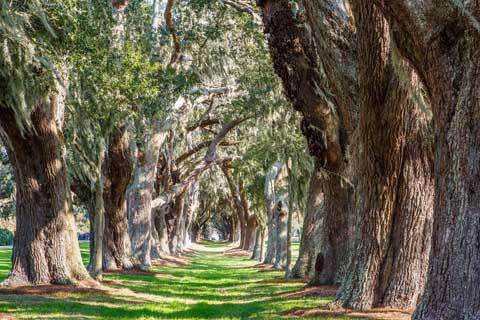How much does it cost to travel to Charleston?
You should plan to spend around $170 per day on your vacation in Charleston. This is the average daily price based on the expenses of other visitors.
Past travelers have spent, on average for one day:
- $58 on meals
- $33 on local transportation
- $180 on hotels
A one week trip to Charleston for two people costs, on average, $2,376. This includes accommodation, food, local transportation, and sightseeing.
All of these average travel prices have been collected from other travelers to help you plan your own travel budget.
Independent Travel
Traveling Independently to Charleston has many benefits including affordabilty, freedom, flexibility, and the opportunity to control your own experiences.
All of the travel costs below are based on the experiences of other independent travelers.
Is Charleston expensive to visit?
Prices in Charleston are reasonable and comparable to your average travel destination. Hotels, food, and sightseeing are generally within normal price ranges.
Within North America, which is known to be an expensive region, Charleston is a moderately priced destination compared to other places. The overall cost of travel here is fair for the region and comparable to Monterey or Hilo.
For more details, and to find out if it's within your travel budget, see Is Charleston Expensive?
How much money do I need for a trip to Charleston?
The average Charleston trip cost is broken down by category here for independent travelers. All of these Charleston travel prices are calculated from the budgets of real travelers.
|
Category
|
Cost
|
|
Accommodation 1
(Double Occupancy)
|
$180
|
|
Local Transportation 1
|
$33
|
|
Food 2
|
$58
|
|
Entertainment 1
|
$22
|
|
Alcohol 2
|
$18 -
53
|
Accommodation Budget in Charleston
Calculated from travelers like you
The average price paid for one person for accommodation in Charleston is $90. For two people sharing a typical double-occupancy hotel room, the average price paid for a hotel room in Charleston is $180. This cost is from the reported spending of actual travelers.
Looking for a hotel in Charleston? Prices vary by location, date, season, and the level of luxury. See below for options.
Transportation Budget in Charleston
Calculated from travelers like you
-
The cost of a taxi ride in Charleston is significantly more than public transportation. On average, past travelers have spent $33 per person, per day, on local transportation in Charleston.
-
Transportation1
Taxis, local buses, subway, etc.
$33
How much does it cost to go to Charleston? Naturally, it depends on the dates. We recommend Kayak because they can find the best deals across all airlines.
The price of renting a car in Charleston will depends on dates, the type of car, the location, and your age. We recommend Kayak because they can find the best deals across all car rental companies.
Food Budget in Charleston
Calculated from travelers like you
-
While meal prices in Charleston can vary, the average cost of food in Charleston is $58 per day. Based on the spending habits of previous travelers, when dining out an average meal in Charleston should cost around $23 per person. Breakfast prices are usually a little cheaper than lunch or dinner. The price of food in sit-down restaurants in Charleston is often higher than fast food prices or street food prices.
-
Food2
Meals for one day
$58
Typical prices for Food in Charleston are listed below. These actual costs are from real travelers and can give you an idea of the prices in Charleston, but your costs will vary based on your travel style and the place where the purchase was made.
Entertainment Budget in Charleston
Calculated from travelers like you
-
Entertainment and activities in Charleston typically cost an average of $22 per person, per day based on the spending of previous travelers. This includes fees paid for admission tickets to museums and attractions, day tours, and other sightseeing expenses.
-
Entertainment1
Entrance tickets, shows, etc.
$22
Typical prices for Entertainment in Charleston are listed below. These actual costs are from real travelers and can give you an idea of the prices in Charleston, but your costs will vary based on your travel style and the place where the purchase was made.
-
Patriots Point (for 2)
$60
Alcohol Budget in Charleston
Calculated from travelers like you
-
The average person spends about $36 on alcoholic beverages in Charleston per day. The more you spend on alcohol, the more fun you might be having despite your higher budget.
-
Alcohol2
Drinks for one day
$36
Last Updated: Feb 27, 2024
Charleston On a Budget
 A Plantation Estate near Charleston, South Carolina
A Plantation Estate near Charleston, South Carolina
Charleston is a beautiful, southern city and seaport town in South Carolina. It has a wonderful, historic downtown area that the city government works hard to maintain. Located on a peninsula that is created by two rivers, the city is a stunning setting with much character. It is a popular place to visit for its culture, architecture and cuisine. In recent years Charleston has gained popularity and it continues to grow as both a regional and international travel destination. With its rising popularity comes increasing costs. Travel costs continue to go up as restaurants and hotels raise their prices, particularly during the peak travel season and holiday periods.
The city's climate is humid subtropical. The winters are mild and the summers are hot and humid. Rain can fall throughout the year, but summer tends to be the wettest season. Warm temperatures can last into November and winters are short and cool. Snow is rare but not unheard of. Hurricane season runs from the summer into the early fall.
Sights
Charleston has no shortage of impressive sights. Beautiful, southern churches dot the city's skyline and you can get a spectacular view of the Arthur Ravenel cable-stay bridge which was finished in 2005. There are also some interesting historic cemeteries that you can wander through.
Some of the top sights in Charleston include the Battery and White Point Gardens, Fort Sumter, the French Quarter, Charles Towne Landing State Historic Site, Circular Congregational Church, Liberty Square, and the Waterfront Park. Simply wandering around Charleston will let you stumble into any number of historic sights. The best way to explore the city is to get lost in its details and hidden gems.
Neighborhoods
Charleston's downtown can be divided into three main sections. The residential area that is referred to as the "South of Broad" district is a residential neighborhood with interesting architecture. The "French Quarter" district is also residential but it has many historic sites as well as art galleries. These two areas sit next to each other near the tip of the peninsula that makes the downtown area. The shopping district runs along King Street between Broad and Calhoun Streets. Market Street is where you'll find the famous, open air market.
Activities
There are popular horsedrawn carriage tours that go through the downtown area. These are a fun option to learn about the history of the area. There's also a ghost tour that is a fun way to learn a little about Charleston, particularly if you have children.
If you want to do some souvenir shopping, head to the market, which has stands stocked with locally made handicrafts, regional cookbooks, and some local spices and snacks. It's definitely worth a stroll through if you've never been to the Charleston area.
Food and Dining
Charleston has become a culinary capital of the south. Low country cuisine is popular in the city and throughout the South Carolina and Georgia coasts. It has been heavily influenced by the area's Caribbean, African, and Cajun roots. The cuisine is regional and delicious. Many restaurants make use of the local specialties and seafood dishes are quite common. Popular dishes include shrimp and grits, barbecue, and she-crab soup.
Restaurants in the downtown area can range from budget friendly to quite expensive. Cafes often have reasonably priced dishes, particularly at lunch. Seafood can get expensive but is well worth the splurge. For more budget friendly options, head outside of the touristy, downtown areas.
Transportation
You can easily make your way around downtown Charleston on foot. This is the best way to explore the area as the streets are compact and you'll get to truly experience the city's atmosphere. If your hotel is downtown and you have no plans to venture into the surrounding area then a car isn't absolutely necessary. However, you'll find cheaper hotels outside of the downtown area so you'll likely want to have your own car. There are also many places worth exploring outside of the downtown area, such as the city's beautiful plantations, and some of the nearby beaches.
There is a very limited public transit system in Charleston. It includes a small number of buses that are operated by the Charleston Area Regional Transportation Authority. Probably the most important bus for visitors is Express Bus Route 4 that runs from the airport to the downtown Visitors Center every hour.
It's possible to catch a taxi and prices are reasonable. Your best option is to call and order a taxi in advance as it can be difficult to flag one down.
Related:
Looking for a
party hostel in Hawaii or
Miami? Traveling alone to
LA or
New Orleans? Want a budget hostel in
NYC?
We've been gathering travel costs from tens of thousands of actual travelers since 2010, and we use the data to calculate average daily travel costs for destinations around the world. We also systematically analyze the prices of hotels, hostels, and tours from travel providers such as Kayak, HostelWorld, TourRadar, Viator, and others. This combination of expenses from actual travelers, combined with pricing data from major travel companies, gives us a uniqe insight into the overall cost of travel for thousands of cities in countries around the world. You can see more here: How it Works.
 A Plantation Estate near Charleston, South Carolina
A Plantation Estate near Charleston, South Carolina

 Budget Your Trip is all about finding out how much everything costs so that you can travel cheaper and longer. Created by avid travelers Laurie and Bryan, our goal is to help you plan your next trip on the right budget. With average daily travel costs that are calculated from the budgets of real travelers, plus an analysis of hotel and tour prices, you can find out how much money you need to plan your next adventure. We also have plenty of travel advice, accommodation reviews, and activity suggestions.
Budget Your Trip is all about finding out how much everything costs so that you can travel cheaper and longer. Created by avid travelers Laurie and Bryan, our goal is to help you plan your next trip on the right budget. With average daily travel costs that are calculated from the budgets of real travelers, plus an analysis of hotel and tour prices, you can find out how much money you need to plan your next adventure. We also have plenty of travel advice, accommodation reviews, and activity suggestions.